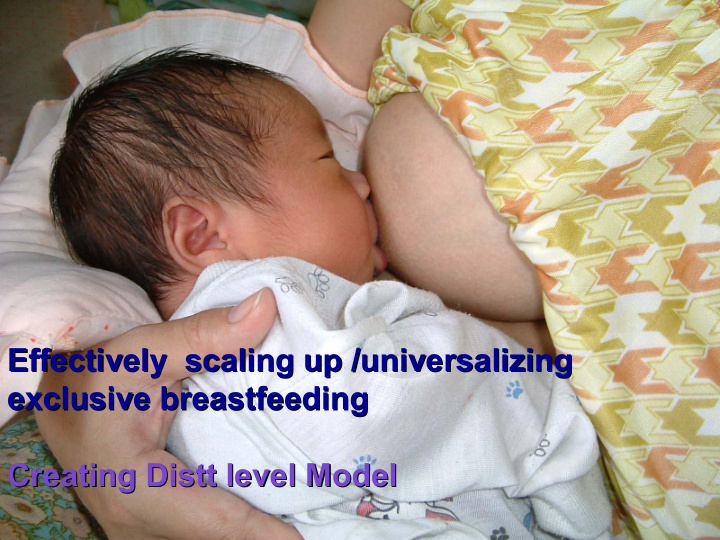



Effectively Scaling Effectively Scaling up/universalizing exclusive up/universalizing exclusive breastfeeding breastfeeding Creating Distt. Level Model Creating Distt. Level Model Effectively scaling up /universalizing Effectively scaling up /universalizing exclusive breastfeeding exclusive breastfeeding Creating Distt level Model Creating Distt level Model
First year is critical! • Malnutrition strikes in infancy from 11 % at 0-6 months reaches its peak by 23 months, then flat. • 36 million under three/ nearly 60 million U-5 are underweight and undernourished thus underdeveloped 2.4 million children die and 2/3 rd in first year • Brain development Underweight (-2sd) NFHS-2 Over 60 million Child deaths U-5 (Lancet 2003 16 Lacs during first year and 8 lacs during next 4 years Years of life
What happens with infants? • 2.4 million U-5 deaths in India(10.9 M global deaths) 2/3 rd during 1 st year alone, according to the WHO , these • are related to inappropriate infant and young child feeding. • Only 40% EX BF for the first 6 months, 33% adequately CF 6-9 months. • Brain development is dependent on level of interaction with the child. Brain development Years of life
Under-5 deaths preventable through universal coverage with individual interventions (2000) Percent India 0% 2% 4% 6% 8% 10% 12% 14% 16% 18% Breastfeeding* Complementary feeding Clean delivery Hib vaccine Clean water, sanitation, hygiene Zinc Intervention Vitamin A Antenatal steroids Newborn temperature management Tetanus toxoid Antibiotics for PRM Measles vaccine Nivirapine and replacement feeding Insecticide-treated materials Antimalarial IPT in pregnancy *Breastfeeding: Exclusive for first 6 months and continued for 6 to 12 months Source: Jones et al. LANCET 2003;362:65-71
Breastfeeding ! • We are a breastfeeding nation • We are “drop outs” in EX BF • Only 90% EX BF can achieve benefits described in Lancet Brain development Breastfeeding status (NFHS-2) Exclusive BF 0-6 months (NFHS-2) 0 6 12 18 24 Months
Exclusive breastfeeding falls rapidly from first month onwards (NFHS-2-1999) Exclusive Breastfeeding 100% 90% 80% 72% 70% Percentages 61% 60% 54.2% 50% 43.3% 40% 37% 30% 25.3% 20% 19.4% 10% 0% <1 1 2 3 4 5 6 Age in Months
Optimal infant and young child feeding Our commitments • Major intervention in RCH II and ICDS • National Guidelines on Infant and Young Child Feeding • IMS Act 1992 and 2003 • 10 th plan goals of exclusive breastfeeding and complementary feeding
10 th Five- Year Plan GOALS Government of India 80.0% 75.0% 50.0% 41.2% 33.5% 15.8% Initiation of Exclusive Complementary breastfeeding within breastfeeding feeding (6-9 months) one hour (0-6 months) NFHS-2 Tenth Plan Goal Note: NFHS 2 data for exclusive breastfeeding is the Simple average of 0-3 & 4-6 months period.
Our response • ASHA’s job: Counseling on IYCF • AWW : health and Nutrition education includes breastfeeding • NNP-NPAN: Ensure exclusive breastfeeding for first ….6 months through high quality training of health workers in lactation management and breastfeeding • RCH II : National breastfeeding ( How ??) partnership • IMNCI: To reach only 125 districts, breastfeeding component needs a clear preventive approach These are not reaching universally
Why Distt. Level models • Focus is on district level planning • Policy makers have raised questions is it doable/feasible?
What it takes ? • Log frame approach/ Goal oriented project planning exercises demonstrate that we need to address several areas altogether. ACTIVITY: RESULTS: OBJECTIVE: GOAL • Recent analysis of policy and programme of IYCF in India revealed that gaps are there in all areas of action and need to be plugged
Why we are here today? • Guidance • Feasibility • How to go forward? • Collaboration formally • Core group: expanding partners • How to do it: to get started, development of project and proposals, strategies, funding etc. • What we can offer to the project? • What mechanisms ? • What next ? 6-12 months
Recommend
More recommend